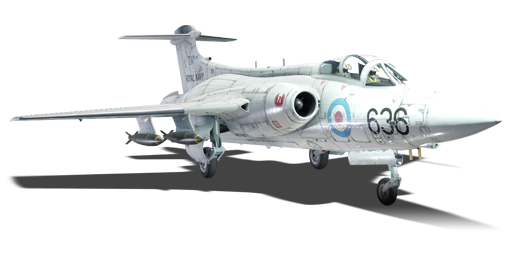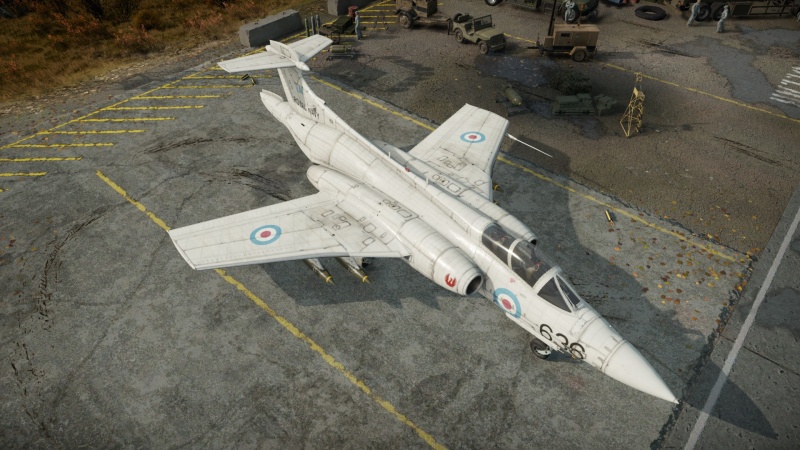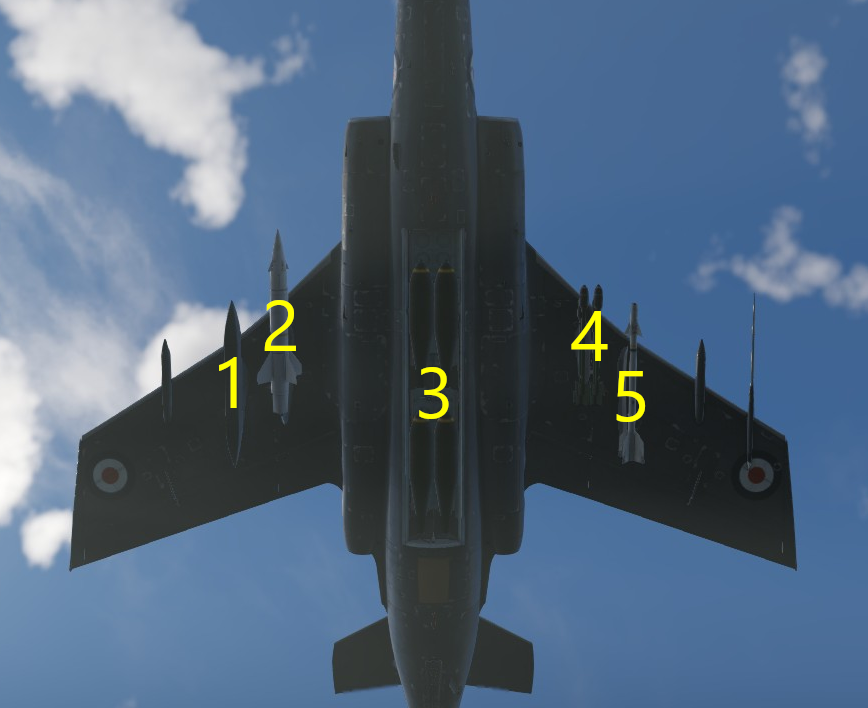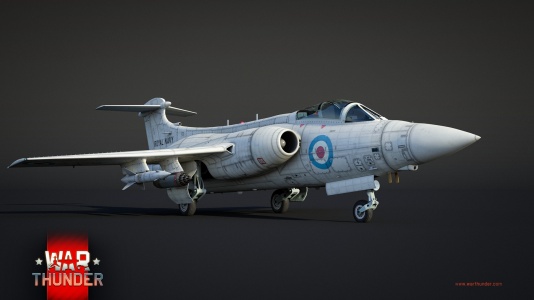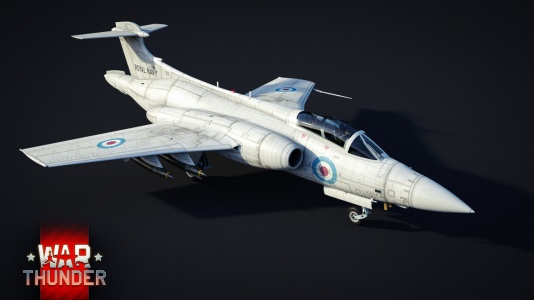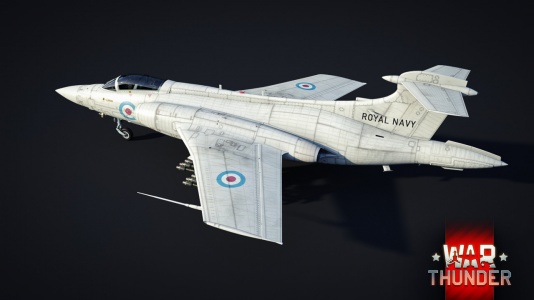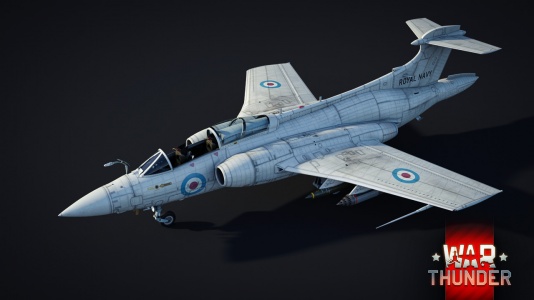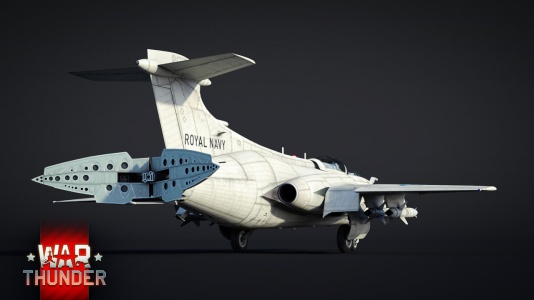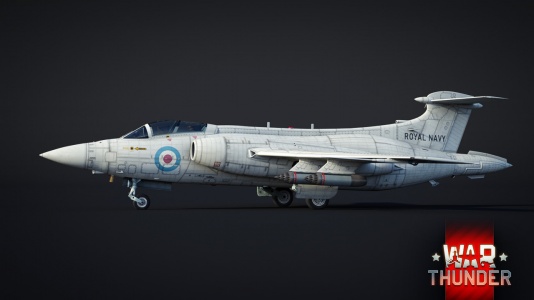Difference between revisions of "Buccaneer S.1"
Colok76286 (talk | contribs) (→Suspended armament: Edits) |
Colok76286 (talk | contribs) (Edits) |
||
| (14 intermediate revisions by 10 users not shown) | |||
| Line 1: | Line 1: | ||
{{About | {{About | ||
| − | | about = gift | + | | about = gift strike aircraft '''{{PAGENAME}}''' |
| − | | usage = | + | | usage = other versions |
| − | | link = Buccaneer | + | | link = Buccaneer (Family) |
}} | }} | ||
{{Specs-Card | {{Specs-Card | ||
| Line 12: | Line 12: | ||
== Description == | == Description == | ||
<!-- ''In the description, the first part should be about the history of and the creation and combat usage of the aircraft, as well as its key features. In the second part, tell the reader about the aircraft in the game. Insert a screenshot of the vehicle, so that if the novice player does not remember the vehicle by name, he will immediately understand what kind of vehicle the article is talking about.'' --> | <!-- ''In the description, the first part should be about the history of and the creation and combat usage of the aircraft, as well as its key features. In the second part, tell the reader about the aircraft in the game. Insert a screenshot of the vehicle, so that if the novice player does not remember the vehicle by name, he will immediately understand what kind of vehicle the article is talking about.'' --> | ||
| − | The '''{{Specs|name}}''' | + | The '''{{Specs|name}}''' was introduced into British service in 1962 as a low-level strike aircraft for the Royal Navy. It was designed to carry a variety of weapons, including nuclear bombs, conventional bombs, rockets, and missiles. The Buccaneer S.1 had a distinctive shape, with a large nose, swept wings, and a tailcone that could be split to become an airbrake. The aircraft was powered by two de Havilland Gyron Junior DGJ.2 turbojets, which gave it a maximum speed of around 650 mph. The Buccaneer S.1 was deployed on several aircraft carriers, such as HMS Ark Royal, HMS Eagle, and HMS Hermes. It saw action in various conflicts, such as the Aden Emergency, and the Beira Patrol. The Buccaneer S.1 was also used for reconnaissance and maritime patrol missions. The Buccaneer S.1 was gradually replaced by the improved Buccaneer S.2, which had more powerful engines, improved avionics, and an increased bomb loadout capacity. The last Buccaneer S.1 was retired from service in 1970. |
| + | |||
| + | The {{Specs|name}} was introduced during [[Update "Red Skies"]] as a reward for the [[wt:en/news/7267-event-summer-landing-en|2021 Summer Landing event]]. It is a unique aircraft, as it is one of the few jet bombers without guns or air-to-air missiles for self-defense. This means that the Buccaneer S.1 is very vulnerable to enemy fighters, especially those with radar and infrared missiles. The Buccaneer S.1 also lacks any countermeasures to evade incoming missiles. Therefore, the best strategy is to fly low and fast, using the terrain and clouds to avoid detection and interception. | ||
== General info == | == General info == | ||
| Line 132: | Line 134: | ||
{{Specs-Avia-Suspended}} | {{Specs-Avia-Suspended}} | ||
<!-- ''Describe the aircraft's suspended armament: additional cannons under the wings, bombs, rockets and torpedoes. This section is especially important for bombers and attackers. If there is no suspended weaponry remove this subsection.'' --> | <!-- ''Describe the aircraft's suspended armament: additional cannons under the wings, bombs, rockets and torpedoes. This section is especially important for bombers and attackers. If there is no suspended weaponry remove this subsection.'' --> | ||
| − | |||
The '''''{{PAGENAME}}''''' can be outfitted with the following ordnance: | The '''''{{PAGENAME}}''''' can be outfitted with the following ordnance: | ||
| + | |||
| + | {| class="wikitable" style="text-align:center" width="100%" | ||
| + | |- | ||
| + | ! !! width="9%" | 1 !! width="9%" | 2 !! width="9%" | 3 !! width="9%" | 4 !! width="9%" | 5 | ||
| + | | rowspan="7" width="30%" | <div class="ttx-image">[[File:Hardpoints_Buccaneer_S.2.png]]</div> | ||
| + | |- | ||
| + | ! [[H.E. M.C. Mk.13 (1,000 lb)|1,000 lb H.E. M.C. Mk.13]] bombs | ||
| + | | || || 4 || || | ||
| + | |- | ||
| + | ! [[H.E. M.C. Mk.13 No.117 (1,000 lb)|1,000 lb H.E. M.C. Mk.13 No.117]] bombs | ||
| + | | 1 || 1 || 4 || 1 || 1 | ||
| + | |- | ||
| + | ! [[L.D H.E. M.C. Mk.1 (1,000 lb)|1,000 lb L.D H.E. M.C. Mk.1]] bombs | ||
| + | | 1 || 1 || || 1 || 1 | ||
| + | |- | ||
| + | ! [[RP]] rockets | ||
| + | | 36 || 36 || || 36 || 36 | ||
| + | |- | ||
| + | ! [[RP-3]] rockets | ||
| + | | 4 || 4 || || 4 || 4 | ||
| + | |- | ||
| + | ! [[AGM-12B Bullpup]] missiles | ||
| + | | 1 || 1 || || 1 || 1 | ||
| + | |- | ||
| + | |} | ||
| + | |||
| + | {{Navigation-Start|Default weapon presets}} | ||
| + | {{Navigation-First-Simple-Line}} | ||
* 4 x 1,000 lb L.D H.E. M.C. Mk.1 bombs (4,000 lb total) | * 4 x 1,000 lb L.D H.E. M.C. Mk.1 bombs (4,000 lb total) | ||
| + | * 8 x 1,000 lb H.E. M.C. Mk.13 No.117 bombs (8,000 lb total) | ||
| + | * 144 x RP rockets | ||
* 16 x RP-3 rockets | * 16 x RP-3 rockets | ||
| − | |||
* 4 x AGM-12B Bullpup missiles | * 4 x AGM-12B Bullpup missiles | ||
| − | + | * 4 x 1,000 lb H.E. M.C. Mk.13 bombs (4,000 lb total) | |
| − | + | {{Navigation-End}} | |
| − | |||
| − | |||
| − | |||
| − | * 4 x 1,000 lb H.E. M.C. Mk.13 bombs | ||
| − | |||
| − | |||
| − | |||
| − | |||
| − | |||
| − | |||
== Usage in battles == | == Usage in battles == | ||
<!-- ''Describe the tactics of playing in the aircraft, the features of using aircraft in a team and advice on tactics. Refrain from creating a "guide" - do not impose a single point of view, but instead, give the reader food for thought. Examine the most dangerous enemies and give recommendations on fighting them. If necessary, note the specifics of the game in different modes (AB, RB, SB).'' --> | <!-- ''Describe the tactics of playing in the aircraft, the features of using aircraft in a team and advice on tactics. Refrain from creating a "guide" - do not impose a single point of view, but instead, give the reader food for thought. Examine the most dangerous enemies and give recommendations on fighting them. If necessary, note the specifics of the game in different modes (AB, RB, SB).'' --> | ||
| − | ' | + | In Realistic Battles, the Buccaneer's focus is bombing as it has zero air-to-air capability. Be careful on take-off with a full load, use most of the runway and get up to a good 350 km/h IAS before retracting gear and flaps. The aircraft can get up to its top-speed in level flight fully-loaded eventually. However, doing this will often lead to bad results. The best tactic is to gently side climb, get to around 550 km/h IAS and then climb at around 12 degrees keeping IAS above 500 km/h until reaching a position to strike from. Keep a careful eye on the positions of enemies and try and stay a healthy distance from them. Line up with the ground targets Drop into a shallow dive which will quickly increase speeds to ~1000 km/h. Once empty, it's often possible to fly straight back to the airfield and reload. On a return trip, if the friendly team has an advantage, fly straight back towards your target otherwise repeat the above manoeuvres. |
| + | |||
| + | Since almost all friendly bombers are going to reach targets first, it's a good idea to guess which targets are still going to be up as to which side to climb on. When picking targets (assuming the use of the loadout with a total of eight 1,000 lb bombs), the wing mounted bombs (1000 lb L.D H.E. M.C. Mk.1) are more powerful and will do roughly 25% damage to a base each and drop in pairs whereas the 4 bombs in the bomb bay (1000 lb H.E. M.C. Mk.13) do roughly 20% damage to a base and drop individually. Speed and positioning are the only defence, generally speaking, if you need to get past an enemy plane, it's not a bad idea to go head-to-head and force them to turn hard to get back onto you, this will often drain enough of their speed that you are out of range by the time they come back around. It's also possible to force enemies past in an emergency by making use of air breaks. Otherwise use friendly aircraft to keep fast enemies off you. | ||
| + | |||
| + | Alternatively, stay very low all the way to the target. Use terrain as physical and psychological barriers against enemies and gain as much straight-line speed as possible. Skirt around the central furball, avoiding enemy aircraft at all costs. Stay low all the way to bomb release, at which point break hard to the left or right and accelerate away from the base you just attacked. If you are carrying a full loadout of bombs, use the externally mounted ones first, as they have more explosive filler and will do more damage. This allows maximum SL profit on the first attack run in case you are destroyed on the run to the second base. Once all of your bombs have been dropped, run straight for your airfield at low level. This maximises speed, which will keep you alive against fighters that have expended their missiles in the furball. | ||
| + | |||
| + | If you are pursued by a faster enemy without missiles, wait until they are just outside of guns range and pull hard up, trying to catch them off guard. Immediately after this pull-up, roll upside down and pull hard down and level out to resume your previous direction of flight. This maneuver will force the enemy to overshoot, allowing you to continue retreating. This maneuver also works against some early IR missiles, such as the AIM-9B and the R-3, which cannot pull hard enough to match it. | ||
| + | |||
| + | Make good use of your RWR, and use it in coordination with the minimap to avoid enemies. | ||
=== Pros and cons === | === Pros and cons === | ||
| Line 188: | Line 216: | ||
;Skins | ;Skins | ||
| + | |||
* [https://live.warthunder.com/feed/camouflages/?vehicle=buccaneer_s1 Skins and camouflages for the {{PAGENAME}} from live.warthunder.com.] | * [https://live.warthunder.com/feed/camouflages/?vehicle=buccaneer_s1 Skins and camouflages for the {{PAGENAME}} from live.warthunder.com.] | ||
Latest revision as of 16:51, 10 June 2024
| This page is about the gift strike aircraft Buccaneer S.1. For other versions, see Buccaneer (Family). |
Contents
Description
The Buccaneer S.1 was introduced into British service in 1962 as a low-level strike aircraft for the Royal Navy. It was designed to carry a variety of weapons, including nuclear bombs, conventional bombs, rockets, and missiles. The Buccaneer S.1 had a distinctive shape, with a large nose, swept wings, and a tailcone that could be split to become an airbrake. The aircraft was powered by two de Havilland Gyron Junior DGJ.2 turbojets, which gave it a maximum speed of around 650 mph. The Buccaneer S.1 was deployed on several aircraft carriers, such as HMS Ark Royal, HMS Eagle, and HMS Hermes. It saw action in various conflicts, such as the Aden Emergency, and the Beira Patrol. The Buccaneer S.1 was also used for reconnaissance and maritime patrol missions. The Buccaneer S.1 was gradually replaced by the improved Buccaneer S.2, which had more powerful engines, improved avionics, and an increased bomb loadout capacity. The last Buccaneer S.1 was retired from service in 1970.
The Buccaneer S.1 was introduced during Update "Red Skies" as a reward for the 2021 Summer Landing event. It is a unique aircraft, as it is one of the few jet bombers without guns or air-to-air missiles for self-defense. This means that the Buccaneer S.1 is very vulnerable to enemy fighters, especially those with radar and infrared missiles. The Buccaneer S.1 also lacks any countermeasures to evade incoming missiles. Therefore, the best strategy is to fly low and fast, using the terrain and clouds to avoid detection and interception.
General info
Flight performance
| Characteristics | Max Speed (km/h at 0 m - sea level) |
Max altitude (metres) |
Turn time (seconds) |
Rate of climb (metres/second) |
Take-off run (metres) | |||
|---|---|---|---|---|---|---|---|---|
| AB | RB | AB | RB | AB | RB | |||
| Stock | 1,094 | 1,087 | 12000 | 34.0 | 34.7 | 33.6 | 31.2 | 900 |
| Upgraded | 1,115 | 1,105 | 30.2 | 32.0 | 51.2 | 42.0 | ||
Details
| Features | |||||
|---|---|---|---|---|---|
| Combat flaps | Take-off flaps | Landing flaps | Air brakes | Arrestor gear | Drogue chute |
| ✓ | ✓ | ✓ | ✓ | ✓ | X |
| Limits | ||||||
|---|---|---|---|---|---|---|
| Wings (km/h) | Gear (km/h) | Flaps (km/h) | Max Static G | |||
| Combat | Take-off | Landing | + | - | ||
| 1181 | 416 | 518 | 463 | 370 | ~9 | ~6 |
| Optimal velocities (km/h) | |||
|---|---|---|---|
| Ailerons | Rudder | Elevators | Radiator |
| < 585 | < 600 | < 548 | N/A |
Engine performance
| Engine | Aircraft mass | |||||||
|---|---|---|---|---|---|---|---|---|
| Engine name | Number | Basic mass | Wing loading (full fuel) | |||||
| de Havilland Gyron Junior DGJ.2 (Mk.101) | 2 | 12,406 kg | 382 kg/m2 | |||||
| Engine characteristics | Mass with fuel (no weapons load) | Max Takeoff Weight | ||||||
| Weight (each) | Type | 15m fuel | 20m fuel | 30m fuel | 45m fuel | 53m fuel | ||
| 1,451 kg | Axial-flow turbojet | 14,071 kg | 14,490 kg | 15,532 kg | 17,094 kg | 17,955 kg | 25,950 kg | |
| Maximum engine thrust @ 0 m (RB/SB) | Thrust to weight ratio @ 0 m (100%) | |||||||
| Condition | 100% | WEP | 15m fuel | 20m fuel | 30m fuel | 45m fuel | 53m fuel | MTOW |
| Stationary | 3,190 kgf | N/A | 0.45 | 0.44 | 0.41 | 0.37 | 0.36 | 0.25 |
| Optimal | 3,254 kgf (1,000 km/h) |
N/A | 0.46 | 0.45 | 0.42 | 0.38 | 0.36 | 0.25 |
Survivability and armour
The Buccaneer S.1 is a large target and does not feature any armour plates or bulletproof glass. All of the aircraft's fuel tanks are mounted down the centre of the aircraft in the upper fuselage (above the bomb bay). The engines are fairly small compared to those on other aircraft but are exposed to enemy fire (they are mounted right at the front near the air intakes).
Much like the Buccaneer S.2 the Buccaneer S.1 uses drooping ailerons (the ailerons deflect downwards with the flaps) to produce additional lift. While offering improved flight performance this has a fairly major drawback in terms of survivability in some situations. As the ailerons are considered parts of the flaps if you exceed your flaps' rip speed then the ailerons will likely be ripped off as well, this can easily lead to loss of control in the immediate aftermath of losing your flaps and make the aircraft very hard to control afterwards.
Modifications and economy
Armaments
| Ballistic Computer | |||
|---|---|---|---|
| CCIP (Guns) | CCIP (Rockets) | CCIP (Bombs) | CCRP (Bombs) |
| |
|
|
|
Suspended armament
The Buccaneer S.1 can be outfitted with the following ordnance:
| 1 | 2 | 3 | 4 | 5 | ||
|---|---|---|---|---|---|---|
| 1,000 lb H.E. M.C. Mk.13 bombs | 4 | |||||
| 1,000 lb H.E. M.C. Mk.13 No.117 bombs | 1 | 1 | 4 | 1 | 1 | |
| 1,000 lb L.D H.E. M.C. Mk.1 bombs | 1 | 1 | 1 | 1 | ||
| RP rockets | 36 | 36 | 36 | 36 | ||
| RP-3 rockets | 4 | 4 | 4 | 4 | ||
| AGM-12B Bullpup missiles | 1 | 1 | 1 | 1 |
| Default weapon presets | |
|---|---|
| |
Usage in battles
In Realistic Battles, the Buccaneer's focus is bombing as it has zero air-to-air capability. Be careful on take-off with a full load, use most of the runway and get up to a good 350 km/h IAS before retracting gear and flaps. The aircraft can get up to its top-speed in level flight fully-loaded eventually. However, doing this will often lead to bad results. The best tactic is to gently side climb, get to around 550 km/h IAS and then climb at around 12 degrees keeping IAS above 500 km/h until reaching a position to strike from. Keep a careful eye on the positions of enemies and try and stay a healthy distance from them. Line up with the ground targets Drop into a shallow dive which will quickly increase speeds to ~1000 km/h. Once empty, it's often possible to fly straight back to the airfield and reload. On a return trip, if the friendly team has an advantage, fly straight back towards your target otherwise repeat the above manoeuvres.
Since almost all friendly bombers are going to reach targets first, it's a good idea to guess which targets are still going to be up as to which side to climb on. When picking targets (assuming the use of the loadout with a total of eight 1,000 lb bombs), the wing mounted bombs (1000 lb L.D H.E. M.C. Mk.1) are more powerful and will do roughly 25% damage to a base each and drop in pairs whereas the 4 bombs in the bomb bay (1000 lb H.E. M.C. Mk.13) do roughly 20% damage to a base and drop individually. Speed and positioning are the only defence, generally speaking, if you need to get past an enemy plane, it's not a bad idea to go head-to-head and force them to turn hard to get back onto you, this will often drain enough of their speed that you are out of range by the time they come back around. It's also possible to force enemies past in an emergency by making use of air breaks. Otherwise use friendly aircraft to keep fast enemies off you.
Alternatively, stay very low all the way to the target. Use terrain as physical and psychological barriers against enemies and gain as much straight-line speed as possible. Skirt around the central furball, avoiding enemy aircraft at all costs. Stay low all the way to bomb release, at which point break hard to the left or right and accelerate away from the base you just attacked. If you are carrying a full loadout of bombs, use the externally mounted ones first, as they have more explosive filler and will do more damage. This allows maximum SL profit on the first attack run in case you are destroyed on the run to the second base. Once all of your bombs have been dropped, run straight for your airfield at low level. This maximises speed, which will keep you alive against fighters that have expended their missiles in the furball.
If you are pursued by a faster enemy without missiles, wait until they are just outside of guns range and pull hard up, trying to catch them off guard. Immediately after this pull-up, roll upside down and pull hard down and level out to resume your previous direction of flight. This maneuver will force the enemy to overshoot, allowing you to continue retreating. This maneuver also works against some early IR missiles, such as the AIM-9B and the R-3, which cannot pull hard enough to match it.
Make good use of your RWR, and use it in coordination with the minimap to avoid enemies.
Pros and cons
Pros:
- Has a maximum payload of 8,000 lb
- Has a Ballistic Computer with both CCIP and CCRP
- CCIP works in level flight unlike on most other aircraft equipped with it
- Has a Head-Up Display in the cockpit which provides flight information and weapon aiming functionality
- Wings are harder to rip than on the Buccaneer S.2
- Bullpup AGM weaponry is excellent for ground targets
- Has a Radar Warning Receiver (RWR)
- Has the ability to land on and take off from aircraft carriers
Cons:
- Has no guns or air-to-air missiles; relies on speed and teammates for survival
- A large and overall defenceless aircraft; likely to be targeted by enemy aircraft
- Has no countermeasures; only means of defence is terrain masking and smart manoeuvring
- Ailerons can be ripped off alongside flaps if you fly too fast
History
Devblog
The Blackburn Buccaneer was developed in the early stages of the Cold War as a response to new cruisers being built by the Soviet Union at the time. After the first prototype conducted its maiden flight in the late 1950's, it didn't take long for the first production version - the Buccaneer S.1 - to enter service with the Fleet Air Arm in the early 1960's.
In service, the Buccaneer S.1 replaced the outdated Supermarine Scimitar in the naval attack role and served throughout the 1960's. In the early 1970's however, several accidents occurred caused by the Buccaneer S.1's troublesome engines. Following this, all Buccaneer S.1s were grounded and decommissioned, ending their service prematurely. However, the much more reliable Buccaneer S.2 replaced the older variant in service and continued its service for many more years.
Media
- Skins
- Images
- Buccaneer S.1 Devblog Images
See also
External links
| Blackburn Aircraft Ltd. | |
|---|---|
| Fighters | Firebrand TF Mk IV · Firecrest |
| Strike aircraft | Buccaneer S.1 · Buccaneer S.2 · Buccaneer S.2B |
| Britain jet aircraft | |
|---|---|
| Blackburn | Buccaneer S.1 · Buccaneer S.2 · Buccaneer S.2B |
| British Aerospace | Harrier GR.7 · Sea Harrier FRS.1 (e) · Sea Harrier FRS.1 · Sea Harrier FA 2 |
| British Aircraft Corporation | Strikemaster Mk.88 |
| English Electric | Canberra B Mk 2 · Canberra B (I) Mk 6 · Lightning F.6 · Lightning F.53 |
| Gloster | Meteor F Mk 3 · Sea Meteor F Mk 3 · Meteor F Mk 4 G.41F · Meteor F Mk 4 G.41G · Meteor F Mk 8 G.41K · Meteor F Mk.8 Reaper |
| Javelin F.(A.W.) Mk.9 | |
| de Havilland | Vampire F.B.5 · Venom FB.4 · Sea Venom FAW 20 · Sea Vixen F.A.W. Mk.2 |
| Hawker | Sea Hawk FGA.6 · Hunter F.1 · Hunter F.6 · Hunter FGA.9 · Harrier GR.1 · Harrier GR.3 |
| Panavia | Tornado GR.1 · Tornado GR.4 · Tornado F.3 · Tornado F.3 Late |
| SEPECAT | Jaguar GR.1 · Jaguar GR.1A · Jaguar IS |
| Supermarine | Attacker FB 1 · Attacker FB.2 · Scimitar F Mk.1 · Swift F.1 · Swift F.7 |
| Foreign | Phantom FG.1 (USA) · Phantom FGR.2 (USA) · F-4J(UK) Phantom II (USA) |
| Australia | F-111C |
| India | ▄MiG-21 Bison |
| South Africa | ▄JAS39C |


